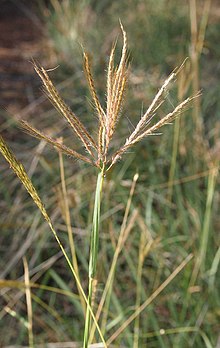Bothriochloa bladhii
| Bothriochloa bladhii | |
|---|---|

| |
| Scientific classification | |
| Kingdom: | Plantae |
| Clade: | Tracheophytes |
| Clade: | Angiosperms |
| Clade: | Monocots |
| Clade: | Commelinids |
| Order: | Poales |
| Family: | Poaceae |
| Subfamily: | Panicoideae |
| Genus: | Bothriochloa |
| Species: | B. bladhii |
| Binomial name | |
| Bothriochloa bladhii | |
| Synonyms[2][3] | |
| |
Bothriochloa bladhii (commonly called, variously, Australian bluestem, Caucasian bluestem, forest-bluegrass, plains bluestem, and purple plume grass)[2] is a Neotropic grass in the family Poaceae, found primarily in tropical Africa, and tropical and temperate Asia, and Australia. The type specimen was collected from China by Finnish botanist Peter Johan Bladh.[3][4] The name of Bladh is honored in the specific epithet.
Distribution
Bothriochloa bladhii is native to Africa from Senegal and Ethiopia southwards to South Africa; the Middle East; much of temperate and tropical, southern and eastern Asia, Malesia, and Australia.[2]
Bothriochloa bladhii has also become naturalized elsewhere in the neotropics.[2]
Uses
Bothriochloa bladhii is used as stored food for local livestock, and as a grazing plant by both livestock and wild ruminants.[2] It is sometimes planted as a revegetator, to restore disturbed land.[2]
References
- ^ Under it treatment as Bothriochloa bladhii (from its basionym Andropogon bladhii), this plant name was first published in Proceedings of the Royal Society of Queensland 80(6): 62–64. 1969. "Name - Bothriochloa bladhii (Retz.) S.T.Blake". Tropicos. Saint Louis, Missouri: Missouri Botanical Garden. Retrieved November 9, 2011.
Basionym: Andropogon bladhii Retz.
- ^ a b c d e f "Bothriochloa bladhii". Germplasm Resources Information Network. Agricultural Research Service, United States Department of Agriculture. Retrieved November 9, 2011.
- ^ a b Andropogon bladhii (the basionym of B. bladhii) was originally described and published in Observationes Botanicae 2: 27. 1781. "Name - Andropogon bladhii Retz". Tropicos. Saint Louis, Missouri: Missouri Botanical Garden. Retrieved November 9, 2011.
Type-Protologue: Collector: Bladh; Distribution: China
- ^ "Entry for Peter Johan Bladh". Index of Botanists. Harvard University Herbarium. May 21, 2009. Retrieved November 9, 2011.
External links
- GrassBase page for Bothriochloa bladhii
- Picture of Bothriochloa bladhii from the Hawaiian Ecosystems at Risk project (HEAR) website, courtesy of the Bishop Museum, Herbarium Pacificum
